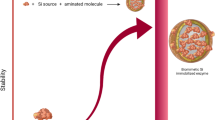Abstract
The aim of this work was to use citric acid in the sol–gel process to generate an inorganic polymer that allows bacterial survival for long periods of time and to study the influence of different storage temperatures. We compared gram-negative Escherichia coli and gram-positive Staphylococcus aureus, immobilized and preserved at different storage temperatures in silica matrices prepared by the method proposed. Immobilized E. coli and S. aureus in silica matrices were stored in sealed tubes at 20, 4, −20, and −70°C for 4 months during which the number of viable cells was analyzed. Results show that the immobilization in silica matrices using citric acid, to neutralize the alkalinity of the silica precursors, makes the technique not only biocompatible but also easier to perform since polymerization does not occur immediately as it does when hydrochloric acid is utilized.


Similar content being viewed by others
References
Avnir D, Coradin T, Lev O, Livage J (2006) Recent bio-applications of sol-gel materials. J Mater Chem 16:1013–1030
Bhatia RB, Brinker CJ, Gupta AK, Singh AK (2000) Aqueous sol-gel process for proteins encapsulation. Chem Mater 12(8):2434–2441
Bjerketorp J, Håkansson S, Belkin S, Jansson JK (2006) Advances in preservation methods: kee** biosensor microorganism alive and active. Curr Opin Biotechnol 17:43–49
Boninsegna S, Bosetti P, Carturan G, Dellagiacoma G, Dal Monte R, Rossi M (2003) Encapsulation of individual pancreatic islets by solgel SiO2: a novel procedure for perspective cellular grafts. J Biotechnol 100:277–286
Branyic T, Kuncova G, Paca J, Demmerova K (1998) Encapsulation of microbial cells into silica gel. J Sol-Gel Sci Technol 13:283–287
Braun S, Rappoport S, Zusman R, Avnir D, Ottolenghi M (1990) Biochemically active sol-gel glasses: the trap** of enzymes. Mater Lett 10:1–5
Brinker CJ, Scherer GW (1990) Sol-Gel Science. The physics and chemistry of sol–gel processing. Academic, San Diego, CA
Carturan G, Dal Toso R, Boninsegna S, Dal Monte R (2004) Encapsulation of functional cells by sol–gel silica: actual progress and perspectives for cell therapy. J Mater Chem 14:2087–2098
Coiffier A, Coradin T, Roux C, Bouvet O, Livage J (2001) Sol–gel encapsulation of bacteria: a comparison between alkoxide and aqueous routes. J Mater Chem 11(8):2039–2044
Conroy JFT, Power ME, Martin J, Earp B, Hosticka B, Daitch CE, Norris PM (2000) Cells in sol-gels I: a cytocompatible route for the production of macroporous silica gels. J Sol-Gel Sci Technol 18:268–283
Desimone MF, De Marzi MC, Copello GJ, Fernández MM, Malchiodi EL, Diaz LE (2005) Efficient preservation in a silicon oxide matrix of Escherichia coli, producer of recombinant proteins. Appl Microbiol Biotechnol 68:747–752
Desimone MF, De Marzi MC, Copello GJ, Fernández MM, Pieckenstain FL, Malchiodi EL, Diaz LE (2006) Production of recombinant proteins by sol-gel immobilized Escherichia coli. Enzyme Microb Technol (in press). DOI https://doi.org/10.1016/j.enzmictec.2005.11.052
Fennouh S, Guyon S, Livage J, Roux C (2000) Sol–gel entrapment of Escherichia coli. J Sol-Gel Sci Technol 19:647–649
Ferrer ML, Levy D, Gomez-Lor B, Iglesias M (2004) High operational stability in peroxidase-catalyzed non-aqueous sulfoxidations by encapsulation within sol–gel glasses. J Mol Catal B Enzym 27:107–111
Guzman NA, Phillips TM (2005) Immunoaffinity CE for proteomics studies. Anal Chem 1:61A–67A
Harms H, Wells MC, Roelof J, van der Meer JR (2006) Whole-cell living biosensors-are they ready for environmental application? Appl Microbiol Biotechnol 70:273–280
Iller RK (1979) The chemistry of silica. Wiley, New York
Lawrence CL, Botting CH, Antrobus R, Coote PJ (2004) Evidence of a new role for the high-osmolarity glycerol mitogen-activated protein kinase pathway in yeast: regulating adaptation to citric acid stress. Mol Cell Biol 24:3307–3323
Liang RP, Qiu HD, Cai PX (2005) A novel amperometric immunosensor based on three-dimensional sol–gel network and nanoparticle self-assemble technique. Anal Chim Acta 534:223–229
Naskar MK (2005) Effects of organic acids on sol-gel transition of silicic acid—a rheological study. J Mater Sci 40:1011–1309
Nassif N, Bouvet O, Rager MN, Roux C, Coradin T, Livage J (2002) Living bacteria in silica gels. Nat Matters 1:42–44
Nassif N, Roux C, Coradin T, Rager MN, Bouvet OMM, Livage J (2003) A sol-gel matrix to preserve the viability of encapsulated bacteria. J Mater Chem 13:1–7
Park KS, Baumstark-Khan C, Rettberg P, Horneck G, Rabbow E, Gu MB (2005) Immobilization as a technical possibility for long-term storage of bacterial biosensors. Radiat Environ Biophys 44:69–71
Pope EJA, Braun K, Peterson CM (1997) Bioartificial organs I: silica gel encapsulated pancreatic islets for the treatment of diabetes mellitus. J Sol-Gel Sci Technol 8:635–639
Premkumar JR, Lev O, Rosen R, Belkin S (2001) Encapsulation of luminous recombinant E. coli in sol-gel silicate films. Adv Mater 13:1773–1775
Acknowledgements
G.S.A. is grateful for her doctoral fellowship granted by the Agencia Nacional de Investigaciones Científicas y Técnicas. M.F.D. is grateful for his post-doctoral fellowship granted by the CONICET. The authors would like to acknowledge the support of grants from the Universidad de Buenos Aires (UBACYT B055 and B817); Consejo Nacional de Investigaciones Científicas y Técnicas (CONICET PIP 02493) and Agencia Nacional de Investigaciones Científicas y Técnicas (BID 1728/OC-AR PICT 14192). L.E.D. is a member of the CONICET Research Counsil. We also wish to thank Professor Rex Davis for language corrections.
Author information
Authors and Affiliations
Corresponding author
Rights and permissions
About this article
Cite this article
Alvarez, G.S., Desimone, M.F. & Diaz, L.E. Immobilization of bacteria in silica matrices using citric acid in the sol–gel process. Appl Microbiol Biotechnol 73, 1059–1064 (2007). https://doi.org/10.1007/s00253-006-0580-6
Received:
Revised:
Accepted:
Published:
Issue Date:
DOI: https://doi.org/10.1007/s00253-006-0580-6




